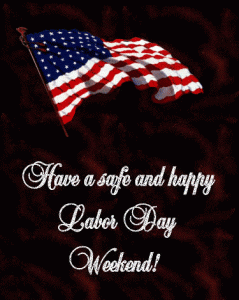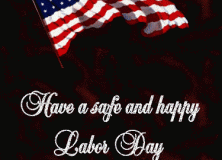 There’s more to Labor Day than just a day off from work, barbeques, or the last chance to enjoy a long weekend in warm weather. Labor Day has come to be celebrated by most Americans as the symbolic end of the summer. In high society, Labor Day is (or was) considered the last day of the year when it is fashionable to wear white.
There’s more to Labor Day than just a day off from work, barbeques, or the last chance to enjoy a long weekend in warm weather. Labor Day has come to be celebrated by most Americans as the symbolic end of the summer. In high society, Labor Day is (or was) considered the last day of the year when it is fashionable to wear white.
In sports, Labor Day marks the beginning of the NFL and college football seasons. NCAA teams usually play their first games the weekend of Labor Day, with the NFL traditionally playing their first game the Thursday following Labor Day. At Indianapolis Raceway Park, the National Hot Rod Association hold their finals to the U.S. Nationals drag race.
Most school districts that started summer vacation 1-2 weeks into June will resume school the day after this day. Pennsylvania currently allows school districts to choose whether to start before or after Labor Day, though legislation has been introduced that would require all schools to begin after Labor Day. So many other events occur on or around Labor Day that many people today don’t know much about the reason Monday is a holiday, other than it is a, “workers’ holiday.
How did Labor Day come to be a Federal Holiday?
At first it was a holiday celebrated by individual states. In 1882, Matthew Maguire, a machinist, first proposed the holiday while serving as secretary of the CLU (Central Labor Union) of New York. Oregon was the first state to make it a holiday on February 21, 1887.
The Federal Government had little interest in making it a national holiday until they found it useful in appeasing unions after much public sentiment turned away from the government following the deaths of a number of workers at the hands of the U.S. military and U.S. Marshals during the Pullman Strike in 1894. During the course of the strike, 30 strikers were killed and 57 were wounded.
The United States Congress unanimously voted to approve rush legislation that made Labor Day a national holiday; President Grover Cleveland signed it into law a mere six days after the end of the strike. By that time, 37 individual states had already made it a holiday since Oregon in 1887. The Pullman Strike, by the way, was unsuccessful and crushed by the same government that honored all laborers.
The form for the celebration of Labor Day was outlined in the first proposal of the holiday: A street parade to exhibit to the public “the strength and esprit de corps of the trade and labor organizations”, followed by a festival for the workers and their families. This became the pattern for Labor Day celebrations. Speeches by prominent men and women were introduced later, as more emphasis was placed upon the civil significance of the holiday. Still later, by a resolution of the American Federation of Labor convention of 1909, the Sunday preceding Labor Day was adopted as Labor Sunday and dedicated to the spiritual and educational aspects of the Labor movement.
Disclaimer: On January 4, 2016, the owner of WestEastonPA.com began serving on the West Easton Council following an election. Postings and all content found on this website are the opinions of Matthew A. Dees and may not necessarily represent the opinion of the governing body for The Borough of West Easton.







